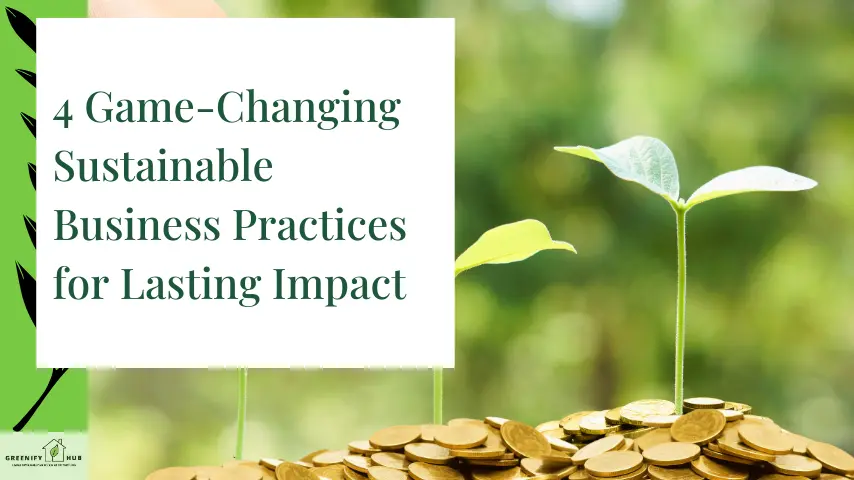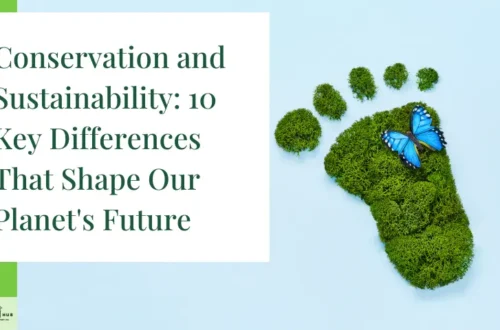4 Game-Changing Sustainable Business Practices for Lasting Impact

Sustainable business practices are no longer just a trend – they’re a necessity.
In today’s world, companies that prioritize sustainability are not only doing good for the planet but also boosting their bottom line.
Imagine a world where your business thrives while also benefiting society and protecting the environment.
It’s not just a dream – it’s achievable with the right strategies.
Let’s dive into four game-changing sustainable business practices that can transform your company and drive long-term success.
These strategies will help you create a sustainable business model that aligns with your goals and values.
From partnering with nonprofits to embracing green technologies, we’ll explore how you can make a positive change in your industry.
Get ready to learn how sustainable business strategies can become the cornerstone of your company’s success.
Implementing sustainable business practices is crucial for driving profits, benefiting society, and protecting the environment, making it a win-win strategy for modern businesses.
Understanding the Triple Bottom Line and Corporate Social Responsibility
Have you ever wondered how businesses can balance profit with social and environmental responsibilities?
Enter the Triple Bottom Line and Corporate Social Responsibility (CSR).
The Triple Bottom Line focuses on three key areas: People, Planet, and Profit.
It’s about creating value beyond just financial gains.
CSR takes this concept further, integrating social and environmental concerns into a company’s operations and interactions with stakeholders.
Think of it as a company’s commitment to “doing good” while doing business.
For example, a clothing company might ensure fair wages for workers (People), use sustainable materials (Planet), and still turn a profit (Profit).
By adopting these principles, businesses can improve their financial performance while practicing good environmental stewardship.
It’s a holistic approach that benefits everyone involved.
The Triple Bottom Line and Corporate Social Responsibility provide a framework for businesses to balance profit with social and environmental benefits, leading to sustainable growth and positive impact.
RELATED: Mastering the 4 Pillars of Sustainability: Your Comprehensive Guide to a Sustainable Future
The Business Case for Sustainability: Driving Profits and Impact
Ever thought that being eco-friendly could actually boost your bottom line?
Well, it’s true! Sustainability isn’t just good for the planet – it’s great for business too.
Consider this: companies that focus on sustainability often see increased profits, improved brand reputation, and greater customer loyalty.
For instance, Unilever’s sustainable living brands grew 69% faster than the rest of its business in 2018.
Sustainability can be a powerful driver of innovation, leading to new products and services that meet evolving consumer demands.
It’s not just a short-term trend, but a long-term goal that can create positive change and give your business a competitive edge.
By making sustainability a strategic choice, you’re investing in the future of your business and the world.
Embracing sustainability can drive profits, foster innovation, and create long-term value, making it an essential business strategy in today’s market.
RELATED: Mastering the Three Es of Sustainability: A Comprehensive Guide for Businesses
Strategy 1: Partnering with Nonprofit Organizations
Ever considered teaming up with a nonprofit to boost your sustainability efforts?
It’s a win-win situation that can amplify your impact and open new doors for your business.
Imagine partnering with an environmental organization to clean up local parks.
Your employees get involved, your brand gains positive exposure, and the community benefits.
Take Patagonia, for example. They’ve partnered with numerous environmental nonprofits, donating 1% of their sales to these causes.
This partnership has not only helped the environment but also strengthened their brand identity and customer loyalty.
Global collaboration with nonprofits can provide expertise, resources, and networks that might be otherwise out of reach.
These partnerships can lead to innovative solutions and create unexpected environmental benefits.
Whether it’s a local charity or an international NGO, finding the right nonprofit partner can amplify your sustainability efforts and drive positive change.
Remember, it’s not just about donating money – it’s about creating meaningful, long-term relationships that benefit everyone involved.
Partnering with nonprofit organizations can enhance a company’s sustainability efforts, providing expertise, resources, and opportunities for meaningful impact while strengthening brand identity and customer loyalty.
Strategy 2: Employee Education and Engagement
Did you know that your employees could be your biggest asset in driving sustainability?
Educating and engaging your team is crucial for implementing successful sustainable practices.
Imagine turning your entire workforce into sustainability champions!
Start by offering workshops on environmental issues and sustainable practices.
For example, Google provides sustainability training to all employees, encouraging them to incorporate eco-friendly practices in their work.
Create green teams within your company to spearhead initiatives.
Salesforce has a “Green Team” in each office location, driving local sustainability efforts.
Don’t forget about your team’s health and well-being.
Incorporate mental health programs and wellness initiatives as part of your sustainability strategy.
For instance, outdoor retailer REI offers “Yay Days” – paid days off for employees to enjoy outdoor activities, promoting both mental health and environmental appreciation.
By investing in employee engagement and education, you’re not just promoting sustainability – you’re building a more committed, motivated workforce.
Employee education and engagement are crucial for implementing sustainable practices, fostering a culture of environmental responsibility, and promoting overall well-being within the organization.
Encouraging Volunteerism and Sustainable Practices
Want to take employee engagement to the next level?
Encourage volunteerism and sustainable practices in their daily lives.
Offer Volunteer Time Off (VTO) for employees to participate in environmental projects.
Timberland, for example, provides 40 paid hours annually for employee volunteering.
Organize company-wide volunteer days focused on local environmental initiatives.
Promote sustainable commuting options like cycling or carpooling.
Incentivize these choices to boost participation.
By fostering a culture of volunteerism and sustainable living, you’re not just meeting consumer demand for ethical practices – you’re creating a more engaged, purpose-driven workforce.
Encouraging volunteerism and sustainable practices among employees fosters a culture of environmental responsibility and meets growing consumer demand for ethical business practices.
Strategy 3: Rethinking Supply Chain Management
Ever stopped to think about the journey your products take before reaching the customer?
Rethinking your supply chain can be a game-changer for sustainability.
Imagine a supply chain that not only delivers products efficiently but also minimizes environmental impact at every step.
Start by mapping your entire supply chain.
Identify areas where you can reduce waste, energy use, and emissions.
Consider adopting a circular economy model.
Instead of the traditional “take-make-dispose” approach, think “reduce-reuse-recycle.”
For example, Dell has implemented a closed-loop recycling system, using plastics from old computers to make new ones.
Collaborate with suppliers who share your sustainability goals.
Walmart, for instance, launched Project Gigaton, challenging suppliers to reduce emissions in their operations.
Rethink your product design to use fewer resources and create less waste.
Adidas has developed shoes made from ocean plastic, turning waste into a valuable resource.
By optimizing your supply chain, you’re not just reducing costs – you’re creating a more resilient, future-proof business model.
Rethinking supply chain management through circular economy principles and sustainable product design can significantly reduce environmental impact while improving efficiency and resilience.
Responsible Sourcing and Ethical Procurement
Ever wondered where your materials come from and how they’re produced?
Responsible sourcing and ethical procurement are key to a sustainable supply chain.
Start by setting clear standards for your suppliers.
Ensure they adhere to fair labor practices and environmental regulations.
Consider using blockchain technology to trace your materials.
For example, IBM’s Food Trust uses blockchain to track food products from farm to store.
Look for certifications like Fair Trade or Forest Stewardship Council (FSC) when sourcing materials.
By prioritizing responsible sourcing, you’re reducing your environmental impact and ensuring ethical practices throughout your supply chain.
Remember, every choice in your procurement process can make a difference in reducing greenhouse gas emissions and promoting sustainability.
Responsible sourcing and ethical procurement are crucial for reducing environmental impact, ensuring fair labor practices, and building a transparent, sustainable supply chain.
Minimizing Resource Consumption and Waste
Ready to trim the fat from your resource consumption?
Minimizing waste isn’t just good for the planet – it’s great for your bottom line too.
Start by conducting a waste audit.
Identify where you’re using resources unnecessarily.
Replace single-use plastics with reusable alternatives.
For instance, swap paper towels for cloth ones in your office kitchen.
Implement a comprehensive recycling program.
TerraCycle partners with businesses to recycle hard-to-recycle materials.
Consider upcycling waste materials into new products.
Patagonia’s WornWear program repairs and resells used clothing.
By minimizing resource consumption and waste, you’re not only reducing costs but also setting an example of responsible business practices.
Minimizing resource consumption and waste through audits, recycling programs, and upcycling initiatives can significantly reduce costs and environmental impact while promoting responsible business practices.
Strategy 4: Embracing Green Technologies and Innovations
Ever thought about how technology could make your business greener?
Embracing green tech and innovations can revolutionize your sustainability efforts.
Imagine powering your entire operation with renewable energy or using AI to optimize resource use.
Start by assessing your current tech infrastructure.
Where can you implement more energy-efficient solutions?
Consider investing in renewable energy sources like solar or wind power.
Google, for instance, aims to run on carbon-free energy 24/7 by 2030.
Explore IoT (Internet of Things) devices to monitor and reduce energy consumption.
Smart thermostats and lighting systems can significantly cut energy use.
Look into green data centers for your digital operations.
Companies like Microsoft are even experimenting with underwater data centers to reduce cooling costs.
Don’t forget about your products.
Can you incorporate green tech into what you offer?
Tesla’s electric vehicles are a prime example of green tech changing an entire industry.
By embracing green technologies, you’re not just reducing your environmental impact – you’re positioning your business at the forefront of innovation.
Embracing green technologies and innovations can significantly reduce environmental impact, cut operational costs, and position a business as a forward-thinking industry leader.
Reducing Carbon Footprint through Smart Solutions
Want to shrink your carbon footprint while growing your business?
Smart solutions can help you achieve both.
Start by calculating your current carbon emissions.
You can’t manage what you don’t measure.
Implement energy management systems to monitor and optimize energy use.
Schneider Electric’s EcoStruxure platform helps businesses reduce energy consumption and carbon emissions.
Consider switching to electric vehicles for your company fleet.
IKEA aims to achieve 100% electric vehicle home deliveries by 2025.
Use smart logistics solutions to optimize transportation routes and reduce fuel consumption.
UPS’s ORION system has saved millions of miles and tons of CO2 emissions.
Don’t forget about your buildings.
Smart HVAC systems and energy-efficient lighting can significantly reduce your carbon footprint.
By implementing these smart solutions, you’re not just reducing your carbon emissions – you’re also cutting costs and improving efficiency.
Remember, every bit of carbon reduction counts in the fight against climate change.
Implementing smart solutions for energy management, transportation, and building operations can significantly reduce a company’s carbon footprint while improving operational efficiency and cutting costs.
RELATED: Conservation and Sustainability: 10 Key Differences That Shape Our Planet’s Future
Implementing Sustainable Practices Across Business Operations
Ready to weave sustainability into the very fabric of your business?
Implementing sustainable practices across your operations can transform your company from the inside out.
Start by creating a sustainability taskforce.
This team can oversee the implementation of green initiatives across departments.
Look at your office products.
Can you switch to recycled paper, eco-friendly cleaning supplies, or energy-efficient electronics?
Consider your energy use.
Could you install solar panels or switch to a green energy provider?
Examine your waste management.
Implement recycling and composting programs, and aim for a zero-waste office.
Don’t forget about water conservation.
Install low-flow faucets and toilets, and fix any leaks promptly.
Encourage sustainable commuting options for employees, like bike-to-work programs or public transit incentives.
Remember, sustainability isn’t a one-time project – it’s an ongoing process of improvement and innovation.
By integrating sustainable practices into every aspect of your business operations, you’re creating a more resilient, efficient, and responsible company.
Implementing sustainable practices across all business operations creates a holistic approach to sustainability, leading to increased efficiency, reduced costs, and a more environmentally responsible company culture.
RELATED: Unleashing Cultural Sustainability: 12 Key Strategies for Thriving Communities
Measuring and Reporting Sustainability Efforts
Ever wondered how to quantify your sustainability efforts?
Measuring and reporting your progress is crucial for accountability and continuous improvement.
Start by setting clear, measurable sustainability goals.
For example, “Reduce carbon emissions by 30% by 2025.”
Use established frameworks like the Global Reporting Initiative (GRI) or the Sustainability Accounting Standards Board (SASB) for standardized reporting.
Track key performance indicators (KPIs) related to environmental issues.
These might include energy consumption, water usage, or waste generation.
Don’t forget about social sustainability metrics, like employee satisfaction or community engagement.
Consider using sustainability management software to collect and analyze data.
Tools like Salesforce Sustainability Cloud can help streamline this process.
Be transparent in your reporting.
Share both successes and challenges in your sustainability journey.
Remember, addressing sustainability issues isn’t just about meeting targets – it’s about continuous improvement and transparency.
By measuring and reporting your efforts, you’re not only tracking progress but also building trust with stakeholders and identifying areas for improvement.
Measuring and reporting sustainability efforts using standardized frameworks and key performance indicators enables businesses to track progress, ensure accountability, and identify areas for improvement in addressing environmental and social issues.
RELATED: 10 Essential Steps to Mastering Social Sustainability: Transform Your Business and Society
Case Studies: Successful Sustainable Business Transformations
Want to see sustainable business practices in action?
Let’s explore some notable examples of companies that have successfully transformed their operations.
Take Patagonia, for instance.
They’ve built their entire business model around sustainability, from using recycled materials to encouraging customers to repair rather than replace their products.
Or consider Unilever’s Sustainable Living Plan.
They’ve committed to sourcing 100% of their agricultural raw materials sustainably, significantly reducing their environmental impact.
IKEA is another great example.
They’re aiming for 100% renewable energy across their operations and have introduced a buyback scheme for used furniture.
Even companies of all sizes are making a difference.
New Belgium Brewing, a mid-sized company, became the first wind-powered brewery in the U.S.
These case studies show that sustainable transformations are possible across various industries and company sizes.
They demonstrate how sustainability can become a core part of a business strategy, driving innovation and growth.
Successful sustainable business transformations across various industries and company sizes demonstrate that integrating sustainability into core business strategies can drive innovation, growth, and positive environmental impact.
RELATED: Economic Sustainability Unveiled: 10 Key Principles for a Thriving Future
The Future of Sustainable Business: Trends and Opportunities
Curious about what’s next in the world of sustainable business?
The future is bright, with exciting trends and opportunities on the horizon.
The energy sector is undergoing a massive transformation, with renewable sources becoming increasingly affordable and efficient.
The global green technology support market is booming, creating opportunities for innovation and investment.
We’re seeing the development of whole new business models centered around sustainability, from circular economy initiatives to sharing economy platforms.
Artificial Intelligence and Big Data are being harnessed to optimize resource use and predict environmental impacts.
There’s a growing focus on biodiversity and ecosystem services in business strategies.
The concept of “net positive” is gaining traction, where businesses aim to give back more than they take from the environment and society.
These trends point to a future where sustainability isn’t just a part of business – it is business.
By staying ahead of these trends, you can position your company for long-term success in a rapidly changing world.
The future of sustainable business is marked by technological advancements, new business models, and a holistic approach to environmental and social impact, offering numerous opportunities for innovation and growth.
RELATED: Environmental Sustainability Unveiled: Key Concepts Shaping Our Future
Conclusion
As we’ve explored the four game-changing sustainable practices, it’s clear that integrating sustainability into your business model is not just an ethical choice, but a strategic imperative. By embracing these practices, you’re positioning your company for long-term success while contributing to a better world. Remember, sustainable business operations are not just about reducing environmental impact; they’re about creating positive change, enhancing financial performance, and meeting growing consumer demand for responsible practices.
Whether you’re partnering with nonprofits, engaging employees, rethinking your supply chain, or adopting green technologies, each step towards sustainability is a step towards a more resilient and profitable future. The journey towards a sustainable business model may seem challenging, but the rewards – both for your company and the planet – are immeasurable.
As you move forward, consider exploring online courses or certificate programs to deepen your understanding of sustainable business strategies. By making sustainability a cornerstone of your company, you’re not just adapting to change – you’re leading it. Transform your business, and be part of the solution for a sustainable tomorrow.





